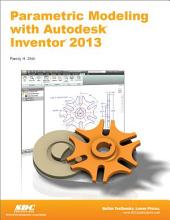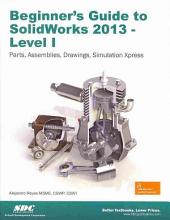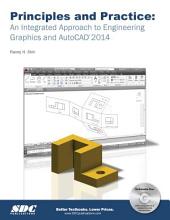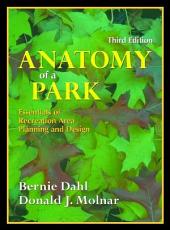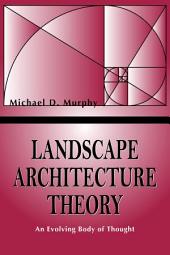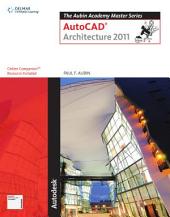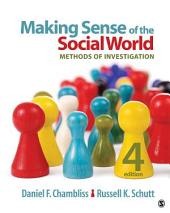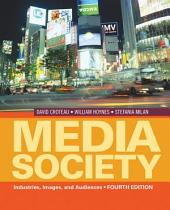Computers + Technology
Parametric Modeling with Autodesk Inventor 2013
Parametric Modeling with Autodesk Inventor 2013 contains a series of sixteen tutorial style lessons designed to introduce Autodesk Inventor, solid modeling, and parametric modeling. It uses a hands-on, exercise-intensive approach to all the import parametric modeling techniques and concepts.
The lessons guide the user from constructing basic shapes to building intelligent mechanical designs, creating multi-view drawings and assembly models. Other featured topics include sheet metal design, motion analysis, 2D design reuse, collision and contact, stress analysis and the Autodesk Inventor 2013 Certified Associate Examination.
Visualization for Engineers and Scientists
Visualization for Engineers and Scientist is the design guide to help students understand the need for graphics in the solution of an engineering design problem. Visualization of an engineering problem is the start of the solution. Engineering graphics represent the outcome of this visualization. This textbook provides the basics for good design communication. The basic understanding of sketching successfully leads students into computer graphics. The understanding of perspective views, orthographic views, and isometric views provide the proper introduction to CAD systems.
AutoCAD 2014 Tutorial - First Level: 2D Fundamentals
The primary goal of AutoCAD 2014 Tutorial - First Level: 2D Fundamentals is to introduce the aspects of Computer Aided Design and Drafting (CADD). This text is intended to be used as a training guide for students and professionals. This text covers AutoCAD 2014 and the lessons proceed in a pedagogical fashion to guide you from constructing basic shapes to making multiview drawings. The lessons are further reinforced by the video presentations found on the enclosed multimedia disc.
This textbook contains a series of eleven tutorial style lessons designed to introduce beginning CAD users to AutoCAD 2014. It takes a hands-on, exercise-intensive approach to all the important 2D CAD techniques and concepts. This text is also helpful to AutoCAD users upgrading from a previous release of the software. The new improvements and key enhancements of the software are incorporated into the lessons. The 2D-CAD techniques and concepts discussed in this text are also designed to serve as the foundation to the more advanced parametric feature-based CAD packages such as Autodesk Inventor.
The basic premise of this book is that the more designs you create using AutoCAD 2014, the better you learn the software. With this in mind, each lesson introduces a new set of commands and concepts, building on previous lessons. This book is intended to help readers establish a good basis for exploring and growing in the exciting field of Computer Aided Engineering.
Complete Digital Photography, Seventh Edition
A Comprehensive Introduction to SolidWorks 2012
This textbook is written to assist students in colleges and universities, designers, engineers and professionals interested in using SolidWorks for practical applications. This textbook was created specifically for both new and intermediate SolidWorks users and will guide students to becoming truly advanced level users.
The textbook is divided into three parts. Part I covers the introductory principles of SolidWorks: simple and advanced-part modeling, assembly modeling, drawing, configuration and design tables, and part modeling with equation driven curves. Part II covers the intermediate principles of SolidWorks: reverse engineering, top-down design, surface modeling, toolboxes and design libraries, animation, and rendering. Part III covers the practice of SolidWorks.
Newcomers to SolidWorks should begin with Part I of the textbook, while intermediate users may skip ahead to Part II. After completing the first two sections, Part III puts the principles learned in the first two sections into practice with specific industry-based examples. The organization of this textbook helps readers find their best path to becoming an advanced SolidWorks user.
The focus of this book is on the areas of manufacturing processes, mechanical systems, electro-mechanical systems, and engineering analysis. The sections on manufacturing processes include the design of molds, sheet metal parts, dies, and weldments. The sections on mechanical systems include aspects of routing such as piping and tubing, power transmission systems, and mechanism design. The section on engineering analysis covers finite element analysis, FEA. Also, the ANSI and ISO standards have been used in this textbook.
This textbook is written using a hands-on approach in which students can follow the steps described in each chapter to model parts, assemble parts, and produce drawings. They create applications on their own with little assistance from their instructors during each teaching session or in the computer laboratory.
This textbook has a significant number of pictorial descriptions of the steps that a student should follow. This approach makes it easy for users of the textbook to work on their own as they use the steps described as guides. Instructional support is also provided, including SolidWorks files for all models, drawings, applications, and answers to end-of-chapter questions.
Technical Drawing 101 with AutoCAD 2014
Technical Drawing 101 covers topics ranging from the most basic, such as making freehand, multiview sketches of machine parts, to the advanced—creating an AutoCAD dimension style containing the style settings defined by the ASME Y14.5-2009 Dimensioning and Tolerancing standard. But un-like the massive technical drawing reference texts on the market, Technical Drawing 101 aims to present just the right mix of information and projects that can be reasonably covered by faculty, and assimilated by students, in one semester. Both mechanical and architectural projects are introduced to capture the interest of more students and to offer a broader appeal. The authors have also created video tutorials for this book in which they demonstrate how to use many of AutoCAD's tools and commands.
The CAD portion of the text incorporates drafting theory whenever possible and covers the basics of drawing setup (units, limits, and layers), the tools of the Draw, Modify, and Dimension toolbars, and the fundamentals of 3D modeling. By focusing on the fundamental building blocks of CAD, Technical Drawing 101 provides a solid foundation for students going on to learn advanced CAD concepts and techniques (paper space, viewports, xrefs, annotative scaling, etc.) in intermediate CAD courses.
In recognition of the diverse career interests of our students, Technical Drawing 101 includes projects in which students create working drawings for a mechanical assembly as well as for an architectural project. We include architectural drawing because our experience has shown that many (if not most) first-semester drafting students are interested in careers in the architectural design field, and that a traditional technical drawing text, which focuses solely on mechanical drawing projects, holds little interest for these students. The multidisciplinary approach of this text and its supporting materials is intended to broaden the appeal of the curriculum and increase student interest and, it is hoped, future enrollments.
Engineering Graphics with SolidWorks 2013 and Video Instruction
Engineering Graphics with SolidWorks 2013 and Video Instruction DVD is written to assist technical school, two year college, four year university instructor/student or industry professional that is a beginner or intermediate SolidWorks user. The book combines the fundamentals of engineering graphics and dimensioning practices with a step-by-step project based approach to learning SolidWorks with the enclosed 1.5 hour Video Instruction DVD. Learn by doing, not just by reading.
The book is divided into two parts: Engineering Graphics and SolidWorks 3D CAD software. In Chapter 1 through Chapter 3, you explore the history of engineering graphics, manual sketching techniques, orthographic projection, isometric projection, multi-view drawings, dimensioning practices and the history of CAD leading to the development of SolidWorks.
In Chapter 4 through Chapter 8, you apply engineering graphics fundamentals and learn the SolidWorks User Interface, Document and System properties, simple parts, simple and complex assemblies, design tables, configurations, multi-sheet, multi-view drawings, Bill of Materials, Revision tables, basic and advanced features. Follow the step-by-step instructions in over 70 activities to develop eight parts, four sub-assemblies, three drawings, and six document templates. Formulate the skills to create and modify solid features to model a 3D FLASHLIGHT assembly. Chapter 9 provides a bonus section on the Certified SolidWorks Associate CSWA program with sample exam questions and initial and final SolidWorks models. Passing the CSWA exam proves to employers that you have the necessary fundamental engineering graphics and SolidWorks competencies.
Review individual features, commands, and tools for each project with the book’s 1.5 hour Video Instruction DVD and SolidWorks Help. The chapter exercises analyze and examine usage competencies based on the project objectives. The book is designed to complement the SolidWorks Tutorials located in the SolidWorks Help menu. Each section explores the SolidWorks Online User’s Guide to build your working knowledge of SolidWorks.
Desired outcomes and usage competencies are listed for each project. Know your objectives up front. Follow the step-by step procedures to achieve your design goals. Work between multiple documents, features, commands, and properties that represent how engineers and designers utilize SolidWorks in industry. The authors developed the industry scenarios by combining their own industry experience with the knowledge of engineers, department managers, vendors, and manufacturers. These professionals are directly involved with SolidWorks every day. Their responsibilities go far beyond the creation of just a 3D model.
Beginner's Guide to Solidworks 2013: Level 1
This book is intended to help new users to learn the basic concepts of SolidWorks and good solid modeling techniques in an easy to follow guide. It will be a great starting point for those new to SolidWorks or as a teaching aid in classroom training to become familiar with the software’s interface, basic commands and strategies as the user completes a series of models while learning different ways to accomplish a particular task.
At the end of this book, you will have a fairly good understanding of the SolidWorks interface and the most commonly used commands for part modeling, assembly and detailing after completing a series of components and their 2D drawings complete with Bill of Materials.
The book focuses on the processes to complete the modeling of a part, instead of focusing on individual software commands or operations, which are generally simple enough to learn.
The author strived hard to include the commands required in the Certified SolidWorks Associate test as listed on the SolidWorks website, as well as several more.
SolidWorks is an easy to use CAD software that includes many time saving tools that will enable new and experienced users to complete design tasks faster than before. Most commands covered in this book have advanced options, which may not be covered in this book. This is meant to be a starting point to help new users to learn the basic and most frequently used commands.
SolidWorks 2013 Part I - Basic Tools
SolidWorks 2013 Part I - Basic Tools introduces new users to the SolidWorks interface, SolidWorks tools and basic modeling techniques. It provides readers with a strong understanding of SolidWorks and covers the creation of parts, assemblies and drawings. Every lesson and exercise in this book was created based on real world projects. Each of these projects have been broken down and developed into easy and comprehensible steps for the reader. Furthermore, at the end of every chapter there are self test questionnaires to ensure that the reader has gained sufficient knowledge from each section before moving on to more advanced lessons. This book takes the approach that in order to understand SolidWorks, inside and out, the reader should create everything from the beginning and take it step by step.
Principles and Practice: An Integrated Approach to Engineering Graphics and Autocad 2014
Principles and Practices: An Integrated Approach to Engineering Graphics and AutoCAD 2014 combines an introduction to AutoCAD 2014 with a comprehensive coverage of engineering graphics principles. By adopting this textbook, you will no longer need to adopt separate CAD and engineering graphics books for your course. Not only will this unified approach give your course a smoother flow, your students will also save money on their textbooks. What's more, the tutorial exercises in this text have been expanded to cover the performance tasks found on the AutoCAD 2014 Certified User Examination.
The primary goal of Principles and Practices: An Integrated Approach to Engineering Graphics and AutoCAD 2014 is to introduce the aspects of engineering graphics with the use of modern Computer Aided Design/Drafting software - AutoCAD 2014. This text is intended to be used as a training guide for students and professionals. The chapters in the text proceed in a pedagogical fashion to guide you from constructing basic shapes to making complete sets of engineering drawings. This text takes a hands-on, exercise-intensive approach to all the important concepts of Engineering Graphics, as well as in depth discussions of CAD techniques.
This textbook contains a series of twelve chapters, with detailed step-by-step tutorial-style lessons designed to introduce beginning CAD users to the graphic language used in all branches of technical industry. The CAD techniques and concepts discussed in the text are also designed to serve as the foundation to the more advanced parametric feature-based CAD packages, such as Autodesk Inventor.
Oxford Handbooks Sale Top Scholarly Essays Now in eBook
The Oxford Handbook of Cognitive Linguistics
The Oxford Handbook of War
The Oxford Handbook of the Reception History of the Bible
The Oxford Handbook of Health Economics
The Oxford Handbook of Credit Derivatives
The Oxford Handbook of Critical Management Studies
The Oxford Handbook of Regulation
The Oxford Handbook of Quantitative Asset Management
The Oxford Handbook of Gender and Politics
The Oxford Handbook on The World Trade Organization
Architecture
Architecture Principia
This is the eBook of the printed book and may not include any media, website access codes, or print supplements that may come packaged with the bound book.
Architecture Principia : Architectural Principles of Material Form provides a comprehensive look at the foundational themes of architecture. Simultaneously fundamental and advanced, the text employs comparative precedents, case studies from across the history of architecture, consistent and clear graphic language, and a parallel visual and textual presentation of each architectural principle. Written by designers, for designers, the text is intended to serve as an analytical handbook of the concepts behind these diverse, formal principles as viewed through the history of architecture.
Statics and Strength of Materials for Architecture and Building Construction: Edition 4
This is the eBook of the printed book and may not include any media, website access codes, or print supplements that may come packaged with the bound book.
Statics and Strength of Materials for Architecture and Building Construction, Fourth Edition, offers students an accessible, visually oriented introduction to structural theory that doesn't rely on calculus. Instead, illustrations and examples of building frameworks and components enable students to better visualize the connection between theoretical concepts and the experiential nature of real buildings and materials. This new edition includes fully worked examples in each chapter, a companion website with extra practice problems, and expanded treatment of load tracing.
Architecture and Capitalism: 1845 to the Present
Architecture and Capitalism tells a story of the relationship between the economy and architectural design. Eleven historians each discuss in brand new essays the time period they know best, looking at cultural and economic issues, which in light of current economic crises you will find have dealt with diverse but surprisingly familiar economic issues.
Google SketchUp for Site Design: A Guide to Modeling Site Plans, Terrain and Architecture
Filled with tutorials from front to back, the book focuses on the start and completion of projects that include rich detail and expression. Each part and chapter of the book builds on the previous chapters and tutorial.
You will learn how to approach modeling site plans, buildings and site elements: from modeling each of these exterior environment elements to piecing them together to generate a singular and expressive model.
The book culminates with tutorials demonstrating effective and simple ways to include grades and terrain using the Sandbox tools and how best to integrate the entire approach with AutoCAD and SketchUp.
Also included are links to supplemental on-line resources such as YouTube tutorials and free tutorial and example models from 3D Warehouse.
The book is useful for all SketchUp proficiency levels including beginners, hobbyists, and professionals.
Architecture and Interior Design: An Integrated History to the Present
This is the eBook of the printed book and may not include any media, website access codes, or print supplements that may come packaged with the bound book.
Architecture and Interior Design: An Integrated History to the Present provides a survey of architecture, interiors, furniture, and decorative arts from the past to the present. It is a completely integrated and interdisciplinary reference for: architecture, architectural details, architectural surface treatments, space planning, interior design, interior architectural features, interior surface treatments, motifs, furniture, color, lighting, textiles, and decorative accessories.
The unique scope allows comparison in all areas of the built environment through the centuries to illustrate historical, social, cultural, and stylistic influences. Narrative and graphics interweave design analysis with architectural and design history.
Relaunching Titanic: Memory and marketing in the New Belfast
Anatomy of a Park: Essentials of Recreation Area Planning and Design, Third Edition
Everyone from the professional to the layperson is affected by what a designer proposes for the development of parklands. The entire community has a stake in the results. Dahl and Molnar enable the reader to experience the aesthetic and functional aspects of park design through the eyes of the people for whom parks are planned, designed, and built. The book bridges the gaps that often exist between park designer and park user, between landscape architect and park board, between administrators and maintenance staff. Readers will enjoy the witty and lively presentation of the principles that govern skillful plan interpretation and effective site design, addressing the modern-day challenges facing landscape architects, park administrators and personnel, and the communities they serve. The third edition includes a detailed treatment of creative funding solutions, including the ins and outs of grant writing and application. Readers will be better able to identify opportunities and generate ideas for building partnerships to help conceive and implement park projects. The authors engage the reader in thought-provoking discussions about multiple-use concepts, nature preservation and energy conservation, the increasing importance of cost-conscious budgeting, the value of good design and durable construction, and the latest in computer-assisted park design and maintenance.
Landscape Architecture Theory: An Evolving Body of Thought
Although we visualize the landscape as a place, it is best understood as a process. Landscape design thus becomes a tool for managing this process of change to create meaningful and compelling places. Landscape Architecture Theory provides an insightful introduction to the evolving body of knowledge that underpins the discipline and practice of landscape architecture. The authors treatment emphasizes the interrelation-ships between the biophysical and human dimensions of the environment and the theories and decision-making processes that issue from these relationships. Students and practitioners alike will appreciate how this comprehensive text integrates knowledge from a wide variety of disciplinesincluding earth science, ecological science, behavioral science, design process, and aestheticswith the theories that have been formulated to apply that knowledge to understanding and shaping the landscape. This understanding, it is hoped, will result in designs that improve both quality of life and quality of the environment.
Basic Elements of Landscape Architectural Design
Singularly highlights landscape architectural elements with clear design principles! Designed to be used as a helpful resource by individuals beginning their careers, Basic Elements of Landscape Architectural Design presents the thoughts and key design theories fundamental to landscape architecture in simple words and illustrations. Still available from Waveland Press, this highly regarded sourcebook offers the vocabulary, significance, characteristics, potential uses, and design guidelines for landform, plant materials, buildings, pavement, site structures, and water in landscape architectural design. It will help your students overcome common mistakes and misconceptions typical in the early phases of their design career and will heighten their understanding and awareness of the major physical components of the outdoor environment.
The Aubin Academy Master Series: AutoCAD Architecture 2011
Important Notice: Media content referenced within the product description or the product text may not be available in the ebook version.
Featured Rental Textbooks
Making Sense of the Social World: Methods of Investigation
Introduction to Leadership: Concepts and Practice
Nonprofit Management: Principles and Practice
Nonprofit Management: Principles and Practice is a comprehensive textbook written for the Nonprofit Management course, covering the scope and structure of the nonprofit sector, leadership of nonprofits, managing the nonprofit organization, fundraising, earned income strategies, financial management, nonprofit lobbying and advocacy, managing international and global organizations, and social entrepreneurship. Written specifically for students, this text integrates research, theory, and the practitioner literature and includes more than is found in the more prescriptive, practitioner-oriented alternatives. Providing an overview suitable for students enrolled in their first course in the field, the book also includes cases and discussions of advanced issues for those with experience.
Key Features:
- Includes a chapter on Social Entrepreneurship, which examines the theories behind this concept as well as the successful practices of high-impact nonprofits around the world
- Takes a balanced approach to varied perspectives and controversial issues and encompasses traditional concepts as well as new approaches and thinking
- Integrates social sciences research, management theory, and practitioner literature Includes mini-cases to enhance student understanding of the issues involved in real-world situations
- Chapter-ending suggestions for further reading and questions for discussion at the end of each chapter help students apply chapter content to actual nonprofit organizations.
The Process of Research in Psychology
Early chapters instroduce important concepts for developing research ideas, subject sampling, ethics, and data collection to help students understand the process of research. Subsequent "Nuts and Bolts" chapters provide more detailed coverage of these topics and the various types of research. This approach creates a logical scaffolding upon which students can build their knowledge.
Key Features:
* chapter organization mirrors the steps in the research process in the first part of the book and then lays out the details of different types of research designs in the second half. This sequence reflects the logical, natural progression of the research process
* the spaced repetition of concepts follows a proven memory/learning model that maximizes student retention
* Thinking About Research sections at the end of chapters provide a summary of a real research study for students to analyze and relate to the chapter content
* examples and activities in each chapter come from a wide range of psychological settings, giving students a useful overview of real research
* end-of-chapter quizzes
New to this Edition:
* updated with more research examples that relate to different designs and clarifies difficult concepts such as internal validity and the relationship between data collection techniques and various research designs
* Using Research feature at the end of selected chapters help students connect research methods knowledge to reports they encounter in their daily lives and from the media
* Why Should I Care About Research discussion added to the end of Chapter 1 helps students put the course and methods skills they are learning in context with their future goals
* Expanded Test Yourself questions at the end of chapters provide more practice for students
* Updated to conform to the latest guidelines of the APA style Manual, 6th Edition
Ancillaries:
* Password-protected Instructor Resource Site include a test bank, PowerPoint slides, sample syllabi, answers/tips for the in-text questions, an answer key for the Lab Manual and class discussion topics and activities.
* An open-access student study site provides chapter summaries and objectives, E-flashcards, Web quizzes, additional SPSS data examples, SAGE journal articles, and additional Web resources.
Environmental Communication and the Public Sphere
Media/Society: Industries, Images, and Audiences
In a society saturated by mass media, from newspapers and magazines, television and radio, to digital video projects and the Internet, iPods and TiVo, most students possess a great deal of media knowledge and experience before they ever enter the classroom. What they often lack, however, is a broader framework for understanding the relationship between media and society.
Media/Society: Industries, Images, and Audiences provides that context and helps students develop skills for critically evaluating both conventional wisdom and onee(tm)s own assumptions about the social role of the media.
Previous editions of Media/Society introduced thousands of students to a sociologically informed analysis of the media process. The Fourth Edition builds on this success with new material on students as producers (e.g., YouTube), revised Internet resources, the latest data on the media industry, new examples from the independent media sector, and updated discussions of media policy, online media, and independent media.
Media/Society is unique among media texts in that it offers:
e A sociological approach that examines overarching relationships between the various components of the media process - the industry, its products, audiences, technology - and the broader social world
e An integrated study of mass media that looks at media technologies, collective influences, and connections between mass media issues that are often treated as separate
e An examination of how economic and political constraints affect the media and how audiences actively construct their own interpretations of media messages
Human Resource Management in Public Service: Paradoxes, Processes, and Problems
Corrections: A Text/Reader
The Practice of Research in Social Work
Qualitative Research Design: An Interactive Approach: An Interactive Approach
“This book uses everyday language that will captivate students’ attention and embed practical knowledge to supplement the technical.”
—Gaetane Jean-Marie, University of Oklahoma
“The key strengths of the text are the passion and the enthusiasm that Dr. Maxwell has for qualitative research after all these years. I feel I can also utilize these concepts on my own research team and take them out of the classroom and into research team meetings with colleagues.”
—Deborah Gioia, University of Maryland, Baltimore
“I really liked this book. I found myself taking notes and saying “yes” so many times because Maxwell captures the research process so well and provides many points worth quoting. As a faculty mentor, I particularly see the value of this book for my students who are conducting qualitative dissertations.”
—Mary S. Enright, Capella University
- David Carlone, The University of North Carolina at Greensboro
"I particularly like the interactive focus and believe that helps students to more realistically engage qualitative research design. It certainly lives up to its billing as a good guidebook, and I appreciate the fact that the author really concentrates on useful content, exercises, insights, and examples, and leaves extensive theory discussions to others."
- Sharon L. Caudle, Texas A & M University
